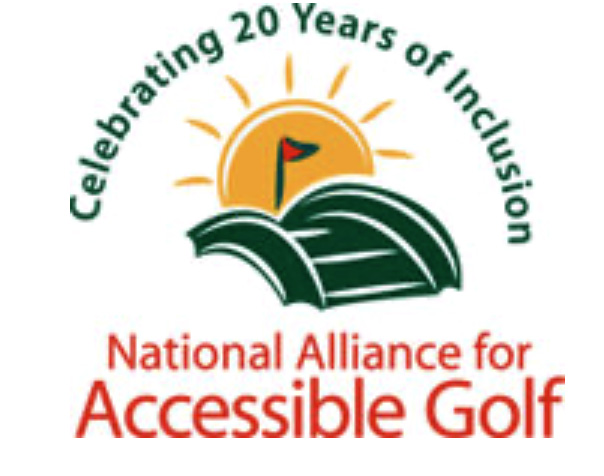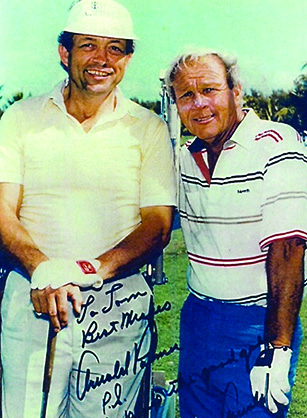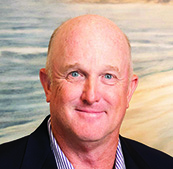
By Dave Barton, PGA
Suffice it to say, individuals with disabilities are not a new thing but, let there be no doubt, the way “we humans” perceive and embrace individuals with disabilities has come a long way in many areas. However, the journey for equality is most decidedly not over for those in our society who look or act “differently” compared to whatever “norms” have been embedded in our brains for centuries.
It might help one’s perspective to remember a simple fact; when it comes to diversity the population of people with disabilities sets the gold standard as any one of us can, at any time, become a part of this population, or become directly connected for the first time to a friend or family member who is disabled.
I won’t go “academic” on you with how disabilities were viewed in the middle ages, by various faiths over the years and by societies in general well into the 20th century. This thing called the “internet” can fill that desire for more detailed information but, you do not have to look far to understand “inclusion” of individuals with disabilities was not a big part of the discussion. Even now, 20% into the 21st century, individuals with disabilities continue to fight on for access and inclusion, otherwise known as just being a part of what everyone else is doing. Is that too much to ask?
Why is this of importance to the Golf Heritage Society? Well, there’s obviously a history related to the societal views of individuals with disabilities, but within that, there is golf. There is also a bright future.
I represent an organization created about 20 years ago, the National Alliance for Accessible Golf[1], with a mission to increase the participation of individuals with disabilities in the game of golf. We do this through serving as an industry resource for education in the golfers with disabilities space, including the Americans with Disabilities Act of 1990 (ADA), as well as the distribution of grants to support golf programs providing the aforementioned participation opportunities. We routinely work with the leading golf associations in the country as well as golf facilities to help them create more welcoming and inclusive environments. We have been strongly supported by the USGA for many years in our ability to continue our mission, as well as the PGA of America, LPGA, NGCOA, ASGCA, GCSAA, GCBAA, CMAA, NCA, ATRA[2], and more.
Per the Center for Disease Control[3], there are 61 million individuals with disabilities in the United States, 1 in 4 people in our country are disabled with mobility, sensory, neurologically, intellectually, and other types, those with mobility disabilities account for 1 in 7 adults, and of the US population, children with disabilities ages 5 to 17 amount to 5.6%.
From a golf perspective[4],
- approximately 14 million individuals are interested in golf,
- 6 million report they had played in the past, but no longer do, and
- more than 600,000 golfers with disabilities are currently engaged in golf.
So many charted a path before we came along, including some of the below, and so many others continue to open up the world of golf to individuals with disabilities such as the US Adaptive Golf Alliance (USAGA), the U.S. Disabled Golf Association (USDGA), the National Amputee Golf Association (NAGA), the U.S. Blind Golf Association (USBGA), the Special Olympics, PGA Hope, The First Tee, regional programs such as Upstate Carolinas Adaptive Golf and individual programs at golf courses, parks and therapeutic organizations including Scottish Rite for Children in Texas and the Ranken Jordan Pediatric Bridge in Missouri. Phenomenal one and all.
Who are the individuals, with disabilities themselves who have led, or continue to lead from the front regarding holding the sport of golf accountable to being truly accessible and inclusive. There are not enough pages in this particular piece to cover them all, but from a golf heritage perspective, these will simply scratch the surface on who I believe are already, or may someday be historically relevant figures in golf:

- Tommy McAuliffe: The self-professed “World Champion Armless Golfer” who lost both arms in a train track accident around the age of 9, did countless demonstrations in the 1920s and 1930s displaying an amazing ability to hit the golf ball[5]. In the video included in the footnotes, Tommy says, “I hope my demonstration will teach the golfers at large that a stiff left wrist, left arm are not essential to a good game of golf and that’s my story and I’m going to stick with it.”
- Dennis Walters: Playing golf on July 21, 1974, thrown from a golf cart resulting in severe spinal cord damage. “Since 1977, Dennis has traveled over 3.5 million miles and has amazed audiences at over 3,000 performances. He uses his own personal experience as an example to challenge each person in the audience to do something in their life that perhaps they thought was impossible.”[6] Dennis was the oldest male competitor in the inaugural USGA U.S. Adaptive Open (U.S. Adaptive Open), conducted July 18-20, 2022, in Pinehurst.
- Bob Wilson: Bob Wilson, who passed away in 2018,[7] served for many years as the executive director of the National Amputee Golf Association. While serving in the U.S. Navy in 1974 as a Landing Signal Officer (LSO), on board the aircraft carrier USS Kitty Hawk, he lost both of his legs due to an arresting cable accident, the steel cable that captures an aircraft while landing[8]. The NAGA was formed after WW-II by 12 men, all with amputations, led by Dale Bourisseau who sought out fellow veterans to encourage them to play golf.
- Judi Brush: With the distinction of being the oldest competitor at 80 years of age in the U.S. Adaptive Open, she continues to send an encouraging and inspirational message to all individuals with disabilities, and for sure women in the competitive areas of the game. “I’ve found in going to these events that often you’re one of five or seven [females], where the men have a larger group to support them,” said Brush. “While some women are uncomfortable and will say they can’t do it, I’ve been known to be hard-headed and not worry about that part of it.”[9]
- Tom Houston[10]: Paralyzed in 1980 after aworkplace accident and a National Alliance for Accessible Golf Advisory board member, Tom could likely be considered the Orville and Wilbur Wright brothers version to “adaptive golf vehicles” the brothers were to aviation. Now 81, he never played golf before his injury, first playing around 1990. However, his search to adapt a normal wheelchair to have more access and maneuverability in all spaces ultimately led to an invitation to play golf. Within 4 or 5 of his first rounds ever played, he ended up playing in an event with Arnold Palmer in a wheelchair with typically thin tires … to wit, Mr. Palmer said to him, “You’re going to need bigger tires!” On Oct 16, 2022, Tom Houston shot his age, a smooth 81.
- Sophie Howard: Sophie was the youngest competitor in the U.S. Adaptive Open at 15 years of age. It gets better. Per Sophie, “There were a lot of firsts for me today – my first round, my first event, my first tee shot,” she said. “Once I calmed down, I got in my zone and did what I needed to do. Not everything clicked like it did during the two practice rounds, but that’s golf.”[11]
- Grace Ann Braxton: Also a participant in the U.S. Adaptive Open has been a Special Olympian since the age of 8, has competed on a global scale, and continues to serve as a shining example for golfers with intellectual disabilities.
- Tommy Morrissey: Although only 11 years old and a multi-sport athlete, Tommy is a tremendous golfer and “ambassador and inspiration for The unLimbed Foundations Financial Aid Fund, known as the Tommy Fund.”[12] In his own words from the foundation website, ”I only have one arm, but I’m using it to save theirs.”
- Amy Bockerstette: Not many golf friends I know failed to see Amy say “I Got This” a few times leading to a par on the famous Par-3 16th hole during a practice round with the pros at the Phoenix Open in 2019. This has led to the creation of the I Got This Foundation[13] and their organization’s efforts to use golf instruction to increase inclusion for individuals with intellectual disabilities in the game of golf.
In all the cases above, there is much more to their individual stories. As indicated everal on the list played in the USGA’s inaugural U.S. Adaptive Open, conducted July 18-20, 2022, in Pinehurst. This event has dumped a bunch of fuel on a fire that was already burning, but has created an energy in the golfers with disabilities space that will be a force for the future.
Why Then and Now? Beyond the individual efforts each of the above made, or continue to make, the future for golfers with disabilities is no doubt better than the past. Golf has come a long way with technological advances in adaptive devices and vehicles since the days of the “World Champion Armless Golfer” Tommy McAuliffe but, this is no time to rest.
Spanish philosopher George Santayana’s quote from 1905 was paraphrased by Winston Churchill in 1948 when he said, “Those who fail to learn from history are doomed to repeat it.”[14]
The road put down by those on the list above, even now still being traveled by many of them, has opened up more paths for subsequent generations also on the list.
I sincerely believe these roads will ever widen and grow in numbers, creating more opportunities for all of those who seek nothing less, or more than the access and inclusion many of us never have to think twice about.
********************

Dave Barton, PGA, is the executive director of the National Alliance for Accessible Golf. Prior to, he was editor, Golf Business Magazine, and senior director of membership and education for the National Golf Course Owners Association after operating and managing golf clubs in Northern Virginia and Pennsylvania with Raspberry Golf Management following his 22-year Navy career. He resides in Charleston, S.C.
[2] Professional Golfers Association of America, Ladies Professional Golf Association, National Golf Course Owners Association, American Society of Golf Course Architects, Golf Course Superintendents Association of America, Golf Course Builders Association of America, Club Management Association of America, National Club Association, American Therapeutic Recreation Association
[3] https://www.cdc.gov/ncbddd/disabilityandhealth/infographic-disability-impacts-all.html
[4] 2018 National Golf Foundation Study
[5] https://www.golfcompendium.com/2020/03/tom-mcauliffe-golfer-with-no-arms.html
[6] https://www.denniswalters.com/about-dennis/
[7] https://www.nashuatelegraph.com/obituaries-memorials/obituaries/2018/03/25/robert-c-wilson/
[8] https://portal.fdu.edu/newspubs/magazine/07ws/Wilson.html
[10] Source: D. Barton interview with Tom Houston
[12] https://unlimbited.org/about-tommy/
[13] https://www.igotthis.foundation/
[14] https://winstonchurchill.org/resources/in-the-media/churchill-in-the-news/folger-library-churchills-shakespeare/
